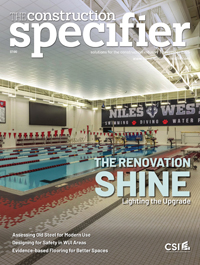Unlocking BHMA’s updated standards

A156.12 establishes the requirements for interconnected locks, including dimensional criteria and operational, strength, security, and cycle tests. These different types of tests are crucial as they relate to the performance and quality of the products. For example, in A156.12, the Dead Bolt Sawing Test states, “dead bolts shall resist sawing through for the period specified when fed into a band saw with a sustained 5 lbf [22 N],” adding specifications on how the force should be applied, the sizing of the blade, and other important test details. One revision made to this section is the inclusion of using a 12.7 mm (0.5 in.) blade in addition to the 6.35 mm (0.25 in.) blade already described in the standard. BHMA opens standards for revision to make sure test methods are clarified for everyone involved, and to update performance testing requirements
when necessary.
Apart from consolidating finish requirements to A156.18, Materials
and Finishes, other revisions include suggested edits to the appendix, clarifications made to section 8.5, and creating separate paragraphs of the requirements in section 10.4. Further, any definitions of terms not directly applicable to the standard were deleted.
ANSI/BHMA A156.13, Mortise Locks and Latches
BHMA standards begin with a scope section followed by a set of definitions in Section 2. A156.13 defines mortise locks as “a lock or latch fitting into a mortised cavity prepared in the edge of a door where the bolts are operated by knobs, levers, turns, thumb pieces, paddles or cylinders that engage with the mortise lock through holes prepared in the faces of the door.” These kinds of locks are often selected for their durability and security as they are considered the most durable, offer additional security, and are meant for heavier duty applications. Standards provide general requirements related to building codes and, depending on the standard, offer descriptions on test methods and detailed test requirements.
Revisions made to this standard include clarified test cylinder requirements to 3.1 and 6.5, “Specified Impact Test location,” updated reference documents, and re-formatted “Bolt Compressive Load Test” section—which applies only to products with a dead-locking latch bolt or a dead bolt. A reference to A156.41, Door Hardware Single Motion To Egress, was also added to emphasize the importance of this standard and its requirements. Lastly and customarily, the final section of a standard includes the function and/or type numbers.
When BHMA revises a standard, new function and type numbers are added when needed, to accommodate innovations. Another revision made to this standard were requirements to cover narrow stile mortise locks, which permit installation within narrow-width aluminum door stiles, and its design allows for installation flexibility for all other types of doors. Narrow stile mortise locks, also known as narrow backset mortise locks, were previously in A156.36, Auxiliary Locks, but it was decided that A156.13 was a more appropriate location for reference and specification. These locks would have lower values than standard mortise locks and several tests would be in addition to existing auxiliary types, therefore new function numbers and tests have been added to A156.13.








